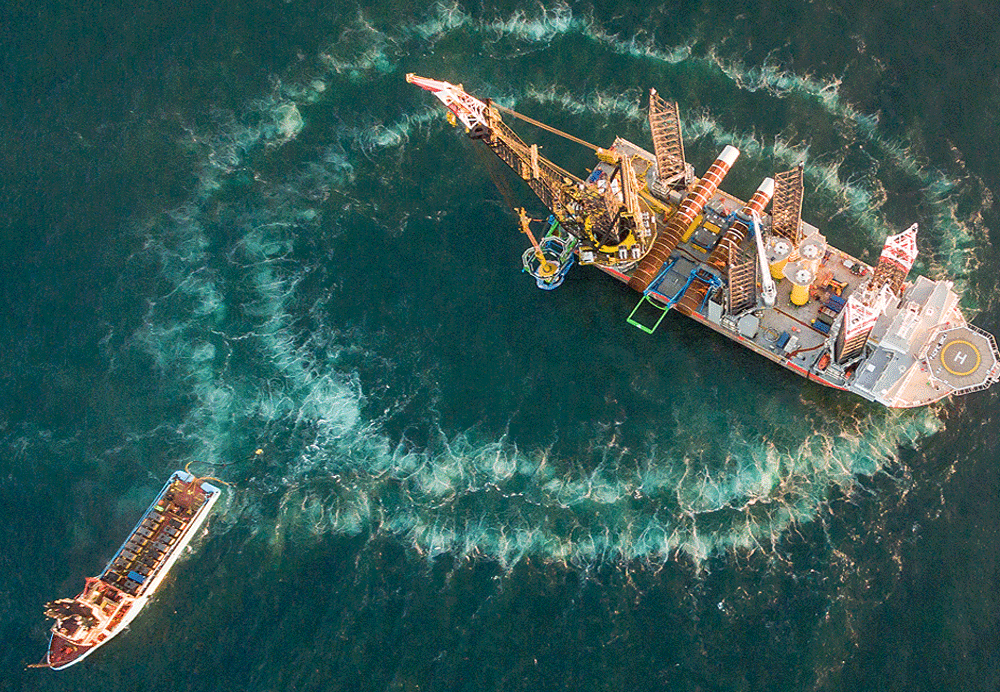Mitigation of underwater noise is a hot topic, especially with the proliferation of offshore wind farm projects across Europe, the US East Coast and parts of Asia. Typically, wind turbine monopiles are driven into the seabed by large hydraulic hammers attached to the tops of the monopiles, a process that generates excessive noise.
These high noise levels can severely disrupt whale and dolphin migration routes, as well as reduce these mammals’ foraging efficiency, increase their stress levels and damage their hearing – and, in some cases, cause physical and fatal injuries. Consequently, some countries are clamping down on offshore wind farm-related noise, although regulatory restrictions vary from state to state. For instance, Taiwan has imposed a noise limit of 160dB, with late-night/early-morning restrictions, for turbine installation activities – as has the US. Similarly, the EU has stipulated that no more than 20% of a given marine area can be exposed to continuous underwater noise over the course of a year. However, the UK has not yet followed suit – a scenario that baffles some industry players, including Barry Craig, VP for North America at air compressor manufacturer ScanTech Offshore, who believes that a regulatory shift is inevitable.
ScanTech Offshore’s contribution to noise mitigation centres on its involvement in the offshore deployment of ‘big bubble curtains’ – essentially, columns of bubbles in the seawater, which surround the monopile and absorb the noise generated during the installation stage. “We’ve mainly used big bubble curtains in UXO disposal projects in the North Sea,” Craig tells Ship & Boat International.
Two main components are required for big bubble curtain generation: air compressors and submergible hoses. Both are installed aboard an offshore support ship – “typically a chartered PSV or anchor-handler”, says Craig – with the hoses extending from the aft of the vessel to the seafloor. Then, air is pumped through each hose, generating a swirling wall of bubbles around the monopile.
Big bubble curtains can also be generated around the bases of rigs and platforms, using the same air compressor/hose combo. Application of this technique dates back to the late 2000s, when it was used in the North Sea to limit noise caused by pile driving during the creation of the research platform Fino 3.
To generate these bubble curtains, ScanTech Offshore uses its ST3100 air compressors in conjunction with a flexible hose system supplied by partner Hydrotechnik Lübeck. Each nozzled hose has an interior diameter of 100-150mm and, depending on the state of the seabed and the current, up to two hose rings can be used simultaneously.
The ST3100 units press air into the hose system at rates of up to 10bar. According to Hydrotechnik Lübeck: “The compressed air escapes through the nozzles provided. The steadily rising air bubbles create a bubble veil, which changes the physical properties of the water. Sound waves are broken several times, reducing the volume by up to 90%.” The hose system is then recovered via a winch after each use. Hydrotechnik Lübeck says that its best results to date include reducing noise levels to 15dB using one hose ring, and to 18dB using two.
The area that the bubble curtain covers is variable, depending on current, wind strength, wave height and water depth, as well as other environmental factors at play within the installation zone, Craig says. One bonus of this technique is that there is zero impact on the seabed or surrounding waters. “Divers, marine mammals and AUVs can safely enter the big bubble curtain, with no harmful effects,” says Craig. “The only setback may be that AUVs have problems with their sensors inside the curtain, perhaps mistaking the bubbles for a wall or a barrier – but this isn’t something we’ve tested yet.”
The ST3100 air compressors are fitted with, and powered by, EPA Tier 4-compliant CAT engines, each rated approximately 1,200hp (895kW). The units are designed to be stacked, with a 150mph fan pushing the generated heat upwards, expelling all hot air from the top. Custom-built for big bubble curtain generation, the ST3100 can deliver “four times more compressed air on the same footprint” compared to similar systems, Craig says. “The stackability of the air compressors reduces the space required, allowing operators to utilise smaller vessels,” he elaborates. “In addition, having a purpose-built solution ensures that the operating environment for both equipment and personnel is maintained well within the desired working parameters, ensuring a safe and reliable solution is provided for the end customer and all of those who work on the project.”
ScanTech Offshore now has a series of big bubble curtain projects on its books, with its ST3100 units booked for Asian, European and North American deployments through to 2025. The group recently shipped 27 stackable air compressors to Taiwan, where they will be used to create bubble curtains around the installation of more than 180 pin piles at one of the country’s in-development turbine sites.
Beyond offshore wind farm foundation installations, big bubble curtains could also be used to blanket noise from other sources, including seismic surveys. The Port of Rotterdam has also been trialling big bubble curtains to assess whether they can be effective in cutting noise pollution generated by regular shipping traffic.






